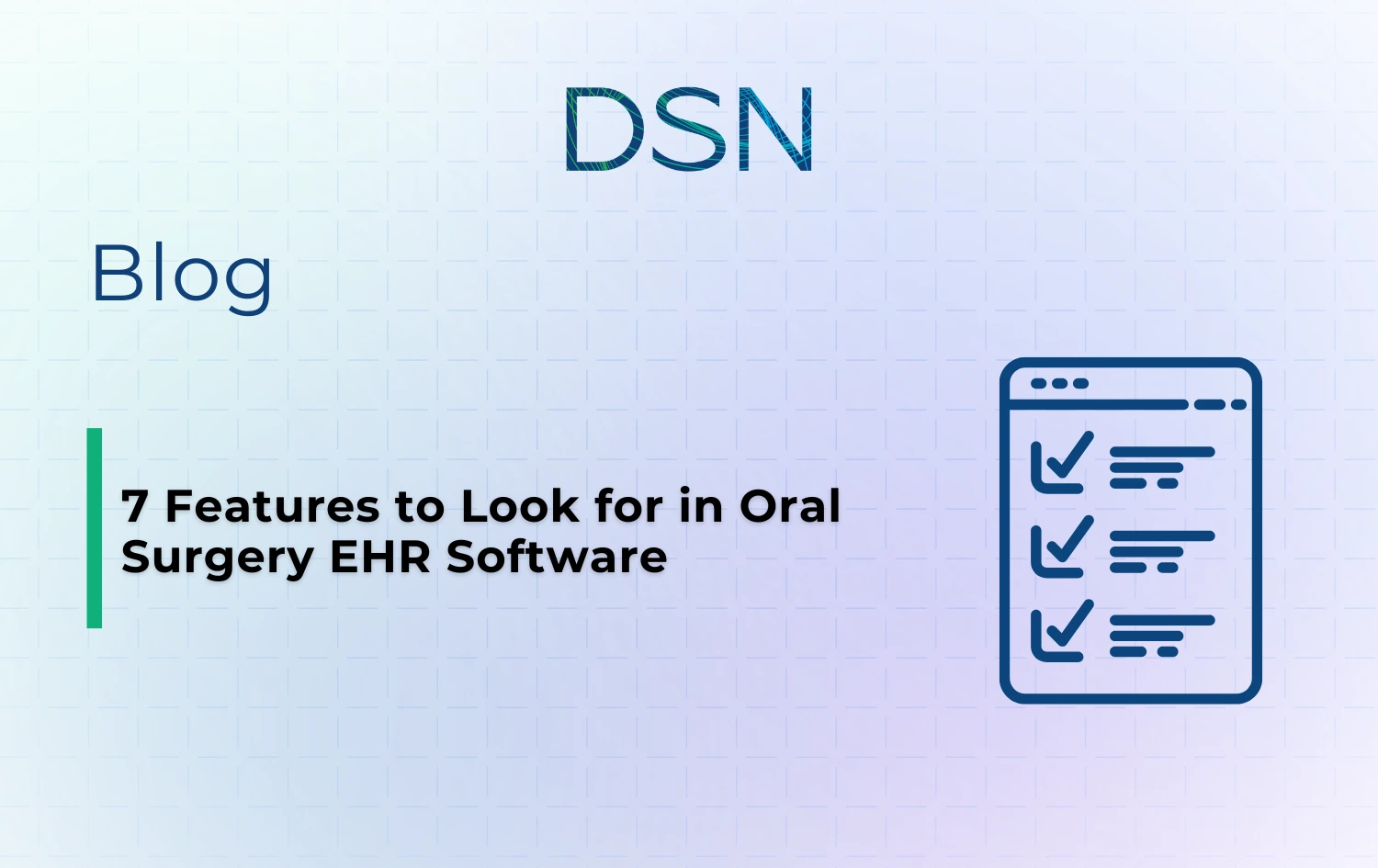Oral surgery EHR software is no longer just a convenience—it is a necessity for practices that want to run efficiently, stay compliant, and give patients the best possible experience. But here’s the challenge: not all systems are built with the unique demands of oral surgery in mind. From managing surgical notes to navigating complex coding and insurance requirements, oral surgeons and practice administrators need more than a generic dental EHR.
If you’re evaluating your options, here are seven must-have features to look for in oral surgery EHR software, along with some insights into how solutions like DSN Cloud and DSN On Prem support these needs.
1. Specialty-Specific Clinical Documentation
One of the biggest frustrations for oral surgeons is working with EHRs designed for general dentistry. Those platforms often don’t offer the templates, workflows, or documentation structures that surgical teams require. A strong oral surgery EHR software should provide:
- Procedure-specific templates for extractions, implants, grafting, and anesthesia
- Support for both medical and dental coding within the same workflow
- Real-time prompts to ensure no critical details are left out
DSN Cloud and On Prem both include specialty-driven templates, giving surgeons a starting point that feels tailored rather than generic. That reduces the risk of missed notes and makes day-to-day charting less of a burden.
2. Integrated Imaging and Charting
Oral surgeons rely heavily on imaging. If your EHR can’t integrate radiographs, CBCT scans, and photos directly into the patient chart, you end up wasting time switching between systems.
The best EHR platforms allow you to store, view, and reference imaging alongside treatment notes and surgical records. With DSN’s systems, imaging is directly connected to the patient file, so you can move from pre-op planning to post-op notes without losing context.
3. Insurance and Coding Support
Let’s be real: coding and claims are one of the biggest headaches in oral surgery practices. Unlike general dentistry, many procedures need to be billed through medical insurance, which comes with its own rules and documentation requirements.
Oral surgery EHR software should simplify this by:
- Providing up-to-date CDT and ICD-10 coding references
- Supporting medical-dental cross-coding within the same claim
- Offering built-in checks that catch mismatched codes before submission
DSN Cloud helps practices reduce claim rejections by pairing clinical documentation with the right billing codes, while DSN On Prem provides a local solution for teams that prefer to keep their systems in-house.
4. Compliance and Security
HIPAA compliance isn’t negotiable. Practices also need audit-ready records and consistent security, whether they run on a server or in the cloud.
When evaluating EHRs, ask questions like:
- Does the system keep an audit trail of who accessed or edited records?
- How are backups handled—automatically in the cloud or manually on-site?
- Is the platform updated regularly to address new compliance requirements?
DSN Cloud takes care of updates and security automatically, while DSN On Prem gives practices direct control over data storage and access. Both paths prioritize compliance, just with different levels of flexibility.
5. Workflow Efficiency Tools
Your EHR should make life easier, not harder. Features that improve daily efficiency include:
- Quick charting shortcuts to cut down on repetitive clicks
- Task lists and reminders for surgical follow-ups and patient communication
- Integrated e-prescriptions to reduce manual paperwork
With these tools, surgeons can spend less time documenting and more time focusing on patient care. This is especially critical at the end of the day when note fatigue sets in.
6. Cloud vs. On-Premise Flexibility
Every oral surgery practice operates differently. Some want the convenience of a cloud-based system they can access anywhere. Others prefer to keep everything on-site for full control.
The right oral surgery EHR software should offer flexibility. DSN is one of the few vendors that supports both:
- DSN Cloud: Access anywhere, automatic updates, and built-in redundancy
- DSN On Prem: Complete control, ideal for practices that prefer local hosting
Having both options means practices can choose the model that fits their comfort level and infrastructure rather than being forced into one setup.
7. Responsive Support and Training
Even the best software falls flat without reliable support. Training, troubleshooting, and ongoing updates are essential, especially in specialty settings where downtime can mean delayed surgeries or billing issues.
One DSN customer put it simply: “The support staff is great. They answer questions quickly and thoroughly. They always follow through until the problem is resolved.” 【source: DSN Reviews】
That kind of responsiveness matters. When you’re running a busy surgical schedule, you need confidence that help is just a call away.
Choosing the Right Oral Surgery EHR Software
Selecting an EHR is one of the most important technology decisions an oral surgery practice will make. To recap, the seven features to prioritize are:
- Specialty-specific documentation
- Integrated imaging and charting
- Insurance and coding support
- Compliance and security
- Workflow efficiency tools
- Cloud vs. on-premise flexibility
- Reliable support and training
Practices that evaluate systems through this lens are more likely to find a solution that actually improves daily operations instead of adding stress.
Final Thoughts
Oral surgery EHR software should do more than store records. It should make your practice more accurate, more efficient, and better prepared for compliance demands. Whether you prefer the flexibility of DSN Cloud or the control of DSN On Prem, the goal is the same: giving your team the tools they need to focus on what matters most—patient care.
If you’d like to see how DSN’s solutions can support your practice, you can schedule a demo anytime at dsn.com/book-a-demo
